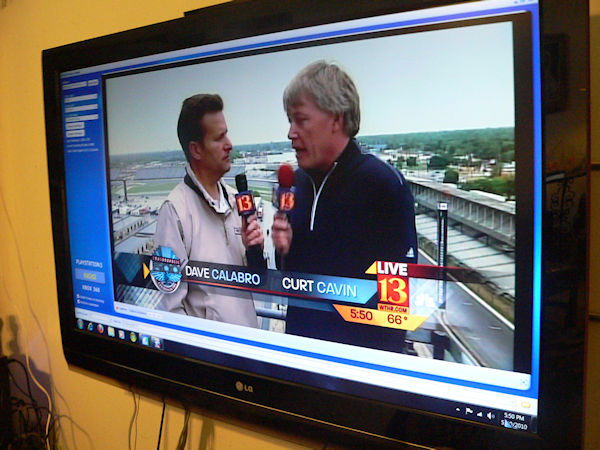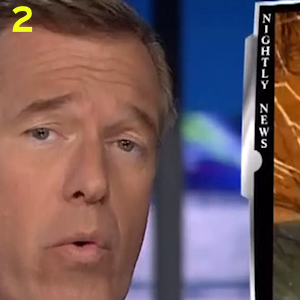Hauppauge HD PVR and Windows Media Center: Is it the working-class TiVo?
"Extreme On" and "Extreme Off," off and on

"Total Media Extreme" bats an 0.333 in the name department. There is nothing particularly total or extreme about it, any more than a wall-based light switch provides "total illumination extreme," or a spoon provides "total cuisine extreme." In terms of functionality, it has less than your average 1990s VCR (countless numbers of which I somehow still own). With it, you get a preview window of the video signal from the STB (the tuner). You can start or stop recording from that window, and you can set a timer ahead of time to do the same; but it records whatever the STB happens to be tuned to at the moment.
 You can change the input source for the signal entering the HD PVR, which is handy if you use HD PVR to transcribe the contents of your camcorder using the alternate composite inputs on the front -- one of HD PVR's very best and most useful features, especially if you find yourself owning a digital camcorder whose drivers fail to work with Windows 7. (Gee, I wonder whom I might be referring to here. . .)
You can change the input source for the signal entering the HD PVR, which is handy if you use HD PVR to transcribe the contents of your camcorder using the alternate composite inputs on the front -- one of HD PVR's very best and most useful features, especially if you find yourself owning a digital camcorder whose drivers fail to work with Windows 7. (Gee, I wonder whom I might be referring to here. . .)
To give the PC more functional control over the STB, Hauppauge does provide IR Blaster software and an infrared cable -- stuff with which diehard PC media aficionados are already too painfully familiar. To make this setup work, you connect the cable to the back of the HD PVR, then find the precise square millimeter of space on the front of your STB beneath which the infrared receiver is lurking, and duct-tape the stem of the IR Blaster cable to that spot. (Duct tape contains the only adhesive that can withstand the extreme temperature changes between a 68-degree room at night, and a 71-degree room during the day, over a six-week period.)
Despite having chosen only the most premium duct tape for the job, I never got IR Blaster to work with Total Media Extreme, not once. As you'll see later, that's not because my Motorola DCH-3200 STB (the LTD Crown Victoria of tuners) isn't capable of handling IR Blaster.
Although it can automatically encode recorded video for playback on PlayStation 3 (M2TS format MPEG-2) or Xbox 360 (MPEG-4), I found that the most reliable format TME supports, capable of being played back without hitches on Windows Media Player and other programs, is the AVCHD (.TS) format originally intended for camcorder compatibility. WMP did not like some of the MP4 files TME produced, and QuickTime liked none of them, although in my tests, they could be imported into video editing software such as Magix Movie Edit Pro 16.
At any event, I was relegated to operating TME manually, including whenever I wanted to record an HD channel that wasn't on ClearQAM. If you already have your own media PC, you already know that it's pointless to set it for sleep mode after so many minutes or hours of use -- that could disrupt a recording or keep a recording from ever happening. That's why my media PC's power profile is set to never shut anything down but the screen after 15 minutes of non-media-player idle time. Total Media Extreme is not Windows Media Player, so you might find yourself watching something through its playback window, and then suddenly the screen shuts off -- you haven't touched it for 15 minutes.
But that's not the cause of Total Media Extreme's biggest problem: On my test system, it freezes between 90 and 120 minutes of continuous recording about one-third of the time. It never freezes on a one-hour show, but it can freeze 80% of the way or longer through a long movie. By "freeze," I mean that the signal from the STB hangs in the preview window, there's no sound, the program is inoperable, and Windows remains active except Task Manager cannot force the program to exit.
However, I was able to perform one test that clearly demonstrates the qualitative difference between an HVR-2250 recording of a ClearQAM signal, and an HD PVR recording of the same channel on Comcast's crowded digital cable spectrum. If ever you've needed undeniable proof that Comcast compresses its HD channels to the extent that further use of the term "high definition" may be inappropriate, here it is.
Click on a segment to see the screenshot in its entirety. WARNING: Large file, lossless PNG.
The example screenshots here were taken from the same NBC Nightly News broadcast, each less than a tenth of a second apart one another, but from two separate recordings made simultaneously (proof, at least, that the two Hauppauge parts can work together). For both pairs, Example 1 is from HVR-2250, Example 2 from HD PVR. These captures were made with lossless PNG format, so any compression you see here is on account of the actual recording, not the screenshot.
Click on a segment to see the screenshot in its entirety. WARNING: Large file, lossless PNG.
The HD PVR/Comcast Digital Cable screen is by no means unwatchable, at least at this particular moment. And certainly MPEG-2 compression has reared its ugly head on many an occasion for both Digital Cable and Comcast ClearQAM, especially during touchdown passes. But take a good look at the crisp edges of white letters on a black background in the ClearQAM capture, that are shattered as if by a blackboard eraser in the Digital Cable capture. Look at Brian Williams' well-combed sideburns, which in Digital Cable are flattened out to a grey swatch of cardboard. Notice the details that simply vanish in the Digital Cable capture, like the spokes of the Ferris wheel and the grilles of the roller coaster. Look closely at the crisp rim of the girl's left eyeglass in ClearQAM, which becomes a jagged staircase in Digital Cable.
This is the key problem when using any kind of analog signal capture device on a digital cable signal: The recording quality can only hope to be as good as that of the recorded signal, which isn't much. It's ironic that CE manufacturers and content providers should both go to such great lengths to limit your ability to record their pristine, unblemished digital signal, prior to their compressing it into lower resolution than a Piet Mondrian painting.
Next: The forced marriage of HD PVR and Windows Media Center




